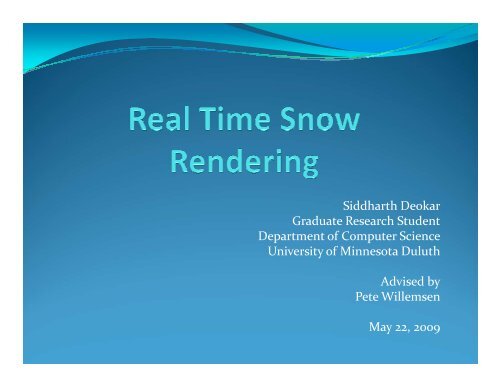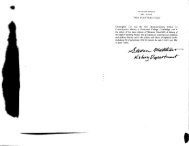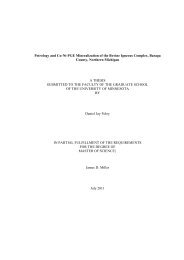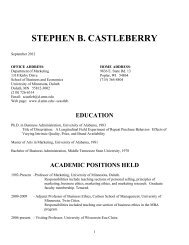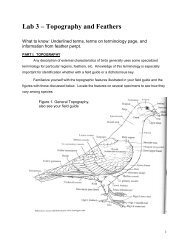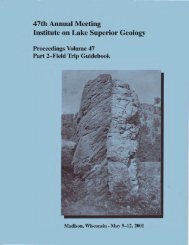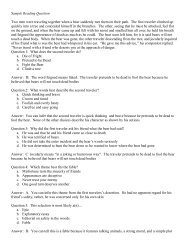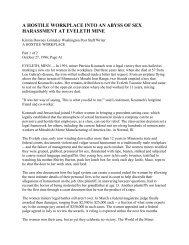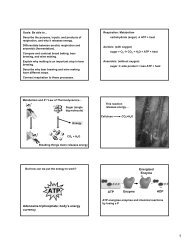Presentation in pdf format - University of Minnesota Duluth
Presentation in pdf format - University of Minnesota Duluth
Presentation in pdf format - University of Minnesota Duluth
Create successful ePaper yourself
Turn your PDF publications into a flip-book with our unique Google optimized e-Paper software.
Siddharth Deokar<br />
Graduate Research Student<br />
Department <strong>of</strong> Computer Science<br />
<strong>University</strong> <strong>of</strong> M<strong>in</strong>nesota <strong>Duluth</strong><br />
Advised by<br />
Pete Willemsen<br />
May 22, 2009
Outl<strong>in</strong>e<br />
Problem Overview<br />
Background<br />
System Overview<br />
Sort<strong>in</strong>g on the GPU & Blend<strong>in</strong>g<br />
Aggregate Snow<br />
LDR, HDR Render<strong>in</strong>g<br />
Model<strong>in</strong>g <strong>of</strong> snow<br />
Results<br />
Conclusion<br />
2
Problem Overview (The Big<br />
Picture)<br />
Snow<strong>in</strong>g conditions<br />
Real Life Problem<br />
<br />
Follow<strong>in</strong>g beh<strong>in</strong>d a snowplow or other vehicles can be dangerous<br />
Difficult to see other vehicles or judge their speed<br />
<br />
Due to poor visibility and snow, it becomes difficult to detect<br />
speed changes <strong>of</strong> other vehicles result<strong>in</strong>g <strong>in</strong> the potential for rear<br />
end collisions<br />
Why snow render<strong>in</strong>g ?<br />
Create a virtual <strong>in</strong>teractive environment where a person can<br />
drive around <strong>in</strong> blow<strong>in</strong>g snow and foggy conditions.<br />
<br />
Understand how we drive <strong>in</strong> snow<strong>in</strong>g conditions<br />
Try to make w<strong>in</strong>ter driv<strong>in</strong>g safe<br />
3
Problem Overview Cont<strong>in</strong>ued…<br />
Goal <strong>of</strong> my research<br />
Effective render<strong>in</strong>g <strong>of</strong> snow<strong>in</strong>g conditions<br />
Improve visual render<strong>in</strong>g <strong>of</strong> snow<br />
<br />
<br />
Interaction between light and snow<br />
Create more realistic scenes<br />
Experiment Framework: Simulated Highway [Pete<br />
Willemsen] & Snow Plow [Michele Olsen]<br />
Video (SnowRender<strong>in</strong>gSimulation.mov)<br />
4
Background<br />
<br />
GPU<br />
Why GPU ?<br />
<br />
<br />
Many Stream Processors<br />
SIMD Architecture<br />
Massive Parallelization<br />
Dedicated for render<strong>in</strong>g high end graphics like video games, 3D games<br />
<br />
Textures<br />
Ma<strong>in</strong> memory structure<br />
<strong>of</strong> a GPU<br />
Each colored square is an <strong>in</strong>dividual<br />
texel, which can be a vector values<br />
Shaders ?<br />
<br />
<br />
One shader for updat<strong>in</strong>g positions<br />
Another Shader for sort<strong>in</strong>g positions<br />
12 13 14 15<br />
8 9 10 11<br />
4 5 6 7<br />
0 1 2 3<br />
5
Background cont<strong>in</strong>ued…<br />
Particle System [Andrew Norgren]<br />
Po<strong>in</strong>t Sprites<br />
<br />
Render millions <strong>of</strong> particles <strong>in</strong> real time<br />
Video (ParticlesAsPo<strong>in</strong>tSprites.mov)<br />
6
System Overview<br />
Sort<strong>in</strong>g & Blend<strong>in</strong>g<br />
Why sort<strong>in</strong>g or blend<strong>in</strong>g ?<br />
Quick Sort<br />
GPU Sort<br />
Additive Blend<br />
Aggregate Snow Effect<br />
High Dynamic Range Render<strong>in</strong>g<br />
Model snow particles<br />
Transparency<br />
Scatter<strong>in</strong>g <strong>of</strong> Light<br />
7
Sort<strong>in</strong>g & Blend<strong>in</strong>g on the GPU<br />
Why is sort<strong>in</strong>g required ?<br />
Objects are drawn <strong>in</strong> a sequence which is provided by<br />
the user <strong>in</strong> his code<br />
Problem with<br />
transparent<br />
objects block<strong>in</strong>g<br />
objects beh<strong>in</strong>d<br />
them<br />
Video (unsorted<br />
particles.mov)<br />
8
Sort<strong>in</strong>g <strong>of</strong> Snow Particles<br />
Sort the particles based on each <strong>in</strong>dividual particle’s<br />
distance from the eye<br />
Euclidean Distance<br />
Quick Sort<br />
Sort<strong>in</strong>g done by CPU<br />
Maps with GPU memory every frame to sort<br />
<br />
Map the particle positions from the vertex buffer to CPU<br />
memory<br />
9
Sort<strong>in</strong>g <strong>of</strong> Snow Particles<br />
Cont<strong>in</strong>ued…<br />
GPU Sort<br />
Inherent Parallelism<br />
Gets rid <strong>of</strong> CPU communication<br />
Faster than us<strong>in</strong>g the best sort<strong>in</strong>g algorithms on the<br />
CPU<br />
<br />
Algorithms like Quick Sort cannot be implemented on the<br />
GPU as it cannot write to arbitrary memory locations<br />
The GPU does not support this functionality to avoid write<br />
after read operations by different stream processors when<br />
access<strong>in</strong>g the same memory location<br />
10
GPU Sort<br />
Implemented by Gov<strong>in</strong>daraju, N., Raghuvanshi, N.,<br />
Henson, M., Tuft, D., Manocha, D. [A Cache Efficient<br />
Sort<strong>in</strong>g Algorithm for Database and Data M<strong>in</strong><strong>in</strong>g<br />
Computations us<strong>in</strong>g Graphics Processors, 2005]<br />
They have used texture mapp<strong>in</strong>g to implement a<br />
bitonic sort algorithm<br />
I have modified the algorithm to suit the sort<strong>in</strong>g <strong>of</strong><br />
particles <strong>in</strong> our system<br />
11
GPU Sort Cont<strong>in</strong>ued…<br />
Bitonic Sequence<br />
A sequence which has at most one local m<strong>in</strong>imum or<br />
maximum<br />
When you break a bitonic sequence at the m<strong>in</strong>imum or<br />
maximum you get two sorted sequences, one ascend<strong>in</strong>g and<br />
the other descend<strong>in</strong>g<br />
Examples: 1,2,3,4,5,6,7,8 2,5,8,10,7,4,3,1<br />
9,8,5,3,6,10,11,12<br />
<br />
<br />
splitt<strong>in</strong>g the second sequence at 10 gives us 2,5,8,10 and 7,4,3,1 which<br />
are sequences <strong>in</strong> ascend<strong>in</strong>g and descend<strong>in</strong>g order respectively<br />
In the third example, the m<strong>in</strong>imum is 3 and splitt<strong>in</strong>g the sequence at<br />
3 gives us 9, 8, 5, 3 and 6, 10, 11, 12 which are sequences <strong>in</strong> descend<strong>in</strong>g<br />
and ascend<strong>in</strong>g order respectively<br />
12
GPU Sort Cont<strong>in</strong>ued…<br />
(Bitonic Sort)<br />
Stage 1: Bitonic Sequence<br />
Created<br />
Stage 2: Bitonic<br />
Sort<br />
Pass 1 Pass 2 Pass 3 Pass 4 Pass 5 Pass 6<br />
13
Example <strong>of</strong> Bitonic Sort<br />
Unsorted Sequence 12 8 14 6 15 10 9 13<br />
Pass 1 12 8 14 6 15 10 9 13<br />
Result 8 12 14 6 10 15 13 9<br />
Pass 2 8 12 14 6 10 15 13 9<br />
Result 8 6 14 12 13 15 10 9<br />
Pass 3 8 6 14 12 13 15 10 9<br />
Bitonic Sequence 6 8 12 14 15 13 10 9<br />
Pass 4 6 8 12 14 15 13 10 9<br />
Result 6 8 10 9 15 13 12 14<br />
Pass 5 6 8 10 9 15 13 12 14<br />
Result 6 8 10 9 12 13 15 14<br />
Pass 6 6 8 10 9 12 13 15 14<br />
Sorted Sequence 6 8 9 10 12 13 14 15<br />
14
GPU Sort Cont<strong>in</strong>ued…<br />
Apply<strong>in</strong>g GPU Sort to our system<br />
The particles are stored <strong>in</strong> a 2-D texture where each cell<br />
holds the position <strong>of</strong> a particle as a 4-D vector<br />
conta<strong>in</strong><strong>in</strong>g values <br />
Calculate Euclidean distance <strong>of</strong> each particle from eye<br />
Indices for particles ?<br />
Indices Distances GPU Sort Sorted Indices<br />
1 2 3 4 25 38 33 28 1 14 9 4<br />
5 6 7 8 + 40 32 27 36 = 16 8 3 12<br />
9 10 11 12 37 34 26 31 13 10 2 7<br />
13 14 15 16 29 35 39 30 5 11 15 6<br />
15
GPU Sort Cont<strong>in</strong>ued…<br />
Drawback<br />
GPU Sort is very fast for a small number <strong>of</strong> particles but<br />
becomes slow as the number <strong>of</strong> particles <strong>in</strong>creases<br />
For example, the time taken to render a frame with one<br />
million particles is more than 0.01 seconds which is necessary<br />
for an <strong>in</strong>teractive environment.<br />
Solution<br />
GPU Sort done over a number <strong>of</strong> passes<br />
It is Fast but,<br />
<br />
<br />
This approach is restricted as the particles are mov<strong>in</strong>g and hence we<br />
cannot have a large number <strong>of</strong> passes to sort the particles <strong>in</strong> a<br />
particular position<br />
On the other hand, by us<strong>in</strong>g a few passes gives us artifacts which are<br />
easily noticeable to the human eye<br />
16
Additive Blend<strong>in</strong>g<br />
Alternative to sort<strong>in</strong>g<br />
Alpha value is used to comb<strong>in</strong>e the color value <strong>of</strong> a<br />
fragment with<br />
the color <strong>of</strong> a<br />
pixel already<br />
stored <strong>in</strong> the<br />
framebuffer<br />
17
GPU Sort and Blend<strong>in</strong>g Cont<strong>in</strong>ued…<br />
Video (Sort<strong>in</strong>g.mov)<br />
18
Aggregate Snow Effects<br />
Snow particles are conf<strong>in</strong>ed <strong>in</strong> a certa<strong>in</strong> doma<strong>in</strong><br />
To show snow particles everywhere is not<br />
computationally feasible<br />
In real world it is hard to see <strong>in</strong>dividual snow particles<br />
after a certa<strong>in</strong> distance<br />
Aggregation <strong>of</strong> snow becomes more prom<strong>in</strong>ent as you<br />
look <strong>in</strong>to the horizon with objects becom<strong>in</strong>g less and<br />
less visible with <strong>in</strong>creas<strong>in</strong>g distance<br />
19
Aggregate Snow Effects Cont<strong>in</strong>ued…<br />
Visibility<br />
As the amount <strong>of</strong> snow <strong>in</strong>creases, visibility decreases<br />
Derive a relation between the snow density <strong>in</strong> our simulation<br />
system and visibility <strong>in</strong> the simulated scene<br />
Video (Real World Aggregation.mov)<br />
20
Aggregation: Snow Density<br />
21
Aggregate Snow Effect<br />
Video (Visibility.mov)<br />
22
High Dynamic Range Render<strong>in</strong>g<br />
Our visual system supports a very high contrast ratio which<br />
is not reflected <strong>in</strong> graphical scenes<br />
Low Dynamic Range Render<strong>in</strong>g<br />
8 bits per color (RGB)<br />
<br />
Contrast ratio <strong>of</strong> 256:1 per color<br />
High Dynamic Range Render<strong>in</strong>g<br />
Better contrast ratio<br />
Create more realistic scenes<br />
Example: Light Source (yellow)<br />
LDR RGB = {1,1,0}<br />
HDR RGB = {4,4,0}<br />
4 times brighter than a light source with <strong>in</strong>tensity {1,1,0}<br />
23
HDR Render<strong>in</strong>g Process<br />
Render Scene<br />
Extract High<br />
Lum<strong>in</strong>ance<br />
Downsample<br />
& Blur<br />
Additive<br />
Blend<strong>in</strong>g<br />
F<strong>in</strong>al Image<br />
Bloom Mask<br />
24
HDR Render<strong>in</strong>g Cont<strong>in</strong>ued…<br />
Render us<strong>in</strong>g<br />
HDR<br />
Extract High Lum<strong>in</strong>ance<br />
Downsampl<strong>in</strong>g & Blur<br />
Bloom Mask<br />
Image rendered<br />
us<strong>in</strong>g HDR<br />
F<strong>in</strong>al Image<br />
25
HDR Render<strong>in</strong>g Cont<strong>in</strong>ued…<br />
HDR Scene is tone mapped <strong>in</strong> order to be displayed on<br />
the monitor<br />
HDR Image Tone Mapp<strong>in</strong>g LDR Image<br />
Tone Mapp<strong>in</strong>g<br />
26
HDR Render<strong>in</strong>g Cont<strong>in</strong>ued…<br />
F<strong>in</strong>al Image displayed on screen<br />
27
Model<strong>in</strong>g <strong>of</strong> Snow<br />
Snow<br />
Translucent particles<br />
<br />
Interact with light to produce scatter<strong>in</strong>g effect<br />
Model shape <strong>of</strong> a snow particle, appearance and<br />
scatter<strong>in</strong>g <strong>of</strong> light due to snow<br />
28
Transparency<br />
Gaussian Function<br />
Gives snow opacity at the centre and becomes<br />
transparent as we move away from the centre<br />
29
Shapes for snow particles<br />
Particles are modeled after actual snow flakes<br />
These images give an outer boundary to our snow<br />
particles so that they resemble actual snowflakes<br />
30
Shapes for snow particles<br />
cont<strong>in</strong>ued…<br />
Particles as snow flakes<br />
Gaussian Transparency<br />
Snow flake<br />
F<strong>in</strong>al Image with<br />
Gaussian transparency<br />
and snow flake shape<br />
31
Dynamic Lights<br />
We can have many lights active <strong>in</strong> the system at any given<br />
moment <strong>of</strong> time<br />
Light source <strong>in</strong><strong>format</strong>ion is available through use <strong>of</strong> textures<br />
Data 1 Position 1 Intensity 1 Direction 1 Spotlight<br />
Parameters 1<br />
Data 2 Position 2 Intensity 2 Direction 2 Spotlight<br />
Parameters 2<br />
Data 3 Position 3 Intensity 3 Direction 3 Spotlight<br />
Parameters 3<br />
Data 4 Position 4 Intensity 4 Direction 4 Spotlight<br />
Use active lights for scatter<strong>in</strong>g calculations<br />
Parameters 4<br />
32
Scatter<strong>in</strong>g<br />
Ray Trac<strong>in</strong>g<br />
Trac<strong>in</strong>g path <strong>of</strong> light through every pixel<br />
Computationally expensive<br />
Phase /Scatter<strong>in</strong>g function<br />
Henyey Greenste<strong>in</strong> Phase Function<br />
<br />
Widely used <strong>in</strong> atmospheric<br />
sciences because <strong>of</strong> its simplicity<br />
eye<br />
θ<br />
33
Scatter<strong>in</strong>g Cont<strong>in</strong>ued…<br />
S<strong>in</strong>gle parameter g (asymmetry parameter) controls<br />
the distribution <strong>of</strong> scattered light<br />
Forward Scatter<strong>in</strong>g<br />
Back Scatter<strong>in</strong>g<br />
34
Scatter<strong>in</strong>g<br />
Video (scatter<strong>in</strong>g.mov)<br />
35
Results<br />
Sort<strong>in</strong>g<br />
4<br />
3.5<br />
3<br />
2.5<br />
2<br />
1.5<br />
Time In 1<br />
seconds<br />
0.5<br />
0<br />
15K 65K 250K 500K 1M 2M<br />
Number <strong>of</strong> Particles<br />
Quick Sort<br />
GPU Sort with<br />
Passes<br />
GPU Sort w/o<br />
Passes<br />
36
Results Cont<strong>in</strong>ued…<br />
GPU Sort (With Passes Vs Without Passes)<br />
0.02<br />
0.018<br />
0.016<br />
0.014<br />
0.012<br />
0.01<br />
0.008<br />
0.006<br />
Time In<br />
seconds<br />
0.004<br />
0.002<br />
0<br />
15K 65K 250K 500K 1M 2M<br />
Number <strong>of</strong> Particles<br />
GPU Sort with<br />
Passes<br />
GPU Sort w/o<br />
Passes<br />
37
Results Cont<strong>in</strong>ued…<br />
Visibility<br />
Image 1 = > Visibility 0.76 (Less snow 6000 particles/s)<br />
Image 2 = > Visibility 0.57 (Heavy Snow 600000 particles/s)<br />
Image 3 = > Visibility 0.16 (Very Heavy Snow 900000<br />
particles/s)<br />
38
Results Cont<strong>in</strong>ued…<br />
Snow Model<br />
OSG Snow (Video – osgSnowRender<strong>in</strong>g.mov)<br />
Our snow model<br />
Snow system with all the effects like Gaussian<br />
transparency, scatter<strong>in</strong>g, HDR and fog<br />
39
Summary<br />
1. Sort the particles based on distance from eye OR use additive blend<br />
2. Model snow particle<br />
3. Get the number <strong>of</strong> lights <strong>in</strong> the scene<br />
4. Calculate color for each particle<br />
5. Calculate effect <strong>of</strong> every light on the particle<br />
6. Apply Gaussian Trans<strong>format</strong>ion<br />
7. Apply Scatter<strong>in</strong>g Function<br />
8. Apply snow aggregation to other objects <strong>in</strong> the scene<br />
9. Render scene to a frame buffer us<strong>in</strong>g HDR for light<strong>in</strong>g calculations<br />
10. Render HDR image<br />
11. Down sample and apply Gaussian blur<br />
12. Apply result<strong>in</strong>g bloom mask to orig<strong>in</strong>al image<br />
13. Render f<strong>in</strong>al image<br />
40
Snow Model<br />
Video (snow.mov)<br />
41
Implementation<br />
Implemented on top <strong>of</strong> particle system created by Andrew<br />
Norgren, Pete Willemsen<br />
Implemented <strong>in</strong> C++ with OpenGL and OpenGL Shad<strong>in</strong>g<br />
Language<br />
Tested on 2.4 GHz AMD Dual Core Processor with a<br />
NVIDIA GeForce 8800 Ultra graphics card<br />
128 Stream Processors<br />
Memory – 728 MB<br />
Matlab for snow density calculations<br />
42
Conclusion<br />
A snow doma<strong>in</strong> which is more realistic to outside world<br />
Individual & Aggregate Snow modeled effectively<br />
Interactive Environment (Real Time !)<br />
Future<br />
Tie visibility with real world data<br />
Sharp snow particles <strong>in</strong> the near plane and blurry snow<br />
(gaussian) at a distance<br />
Sort<strong>in</strong>g particles near the viewer<br />
Shadow<strong>in</strong>g<br />
43
Acknowledgements<br />
Pete Willemsen<br />
L. Zimmerman<br />
Andrew Norgren, Michele Olsen<br />
44
Thank You<br />
Questions ?


